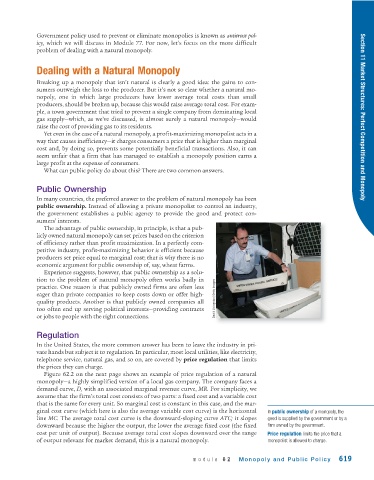Page 661 - Krugmans Economics for AP Text Book_Neat
P. 661
Government policy used to prevent or eliminate monopolies is known as antitrust pol-
icy, which we will discuss in Module 77. For now, let’s focus on the more difficult
problem of dealing with a natural monopoly.
Dealing with a Natural Monopoly
Breaking up a monopoly that isn’t natural is clearly a good idea: the gains to con-
sumers outweigh the loss to the producer. But it’s not so clear whether a natural mo-
nopoly, one in which large producers have lower average total costs than small
producers, should be broken up, because this would raise average total cost. For exam-
ple, a town government that tried to prevent a single company from dominating local
gas supply—which, as we’ve discussed, is almost surely a natural monopoly—would Section 11 Market Structures: Perfect Competition and Monopoly
raise the cost of providing gas to its residents.
Yet even in the case of a natural monopoly, a profit-maximizing monopolist acts in a
way that causes inefficiency—it charges consumers a price that is higher than marginal
cost and, by doing so, prevents some potentially beneficial transactions. Also, it can
seem unfair that a firm that has managed to establish a monopoly position earns a
large profit at the expense of consumers.
What can public policy do about this? There are two common answers.
Public Ownership
In many countries, the preferred answer to the problem of natural monopoly has been
public ownership. Instead of allowing a private monopolist to control an industry,
the government establishes a public agency to provide the good and protect con-
sumers’ interests.
The advantage of public ownership, in principle, is that a pub-
licly owned natural monopoly can set prices based on the criterion
of efficiency rather than profit maximization. In a perfectly com-
petitive industry, profit-maximizing behavior is efficient because
producers set price equal to marginal cost; that is why there is no
economic argument for public ownership of, say, wheat farms.
Experience suggests, however, that public ownership as a solu-
tion to the problem of natural monopoly often works badly in
practice. One reason is that publicly owned firms are often less
eager than private companies to keep costs down or offer high-
quality products. Another is that publicly owned companies all David Livingston/Getty Images
too often end up serving political interests—providing contracts
or jobs to people with the right connections.
Regulation
In the United States, the more common answer has been to leave the industry in pri-
vate hands but subject it to regulation. In particular, most local utilities, like electricity,
telephone service, natural gas, and so on, are covered by price regulation that limits
the prices they can charge.
Figure 62.2 on the next page shows an example of price regulation of a natural
monopoly—a highly simplified version of a local gas company. The company faces a
demand curve, D, with an associated marginal revenue curve, MR. For simplicity, we
assume that the firm’s total cost consists of two parts: a fixed cost and a variable cost
that is the same for every unit. So marginal cost is constant in this case, and the mar-
ginal cost curve (which here is also the average variable cost curve) is the horizontal In public ownership of a monopoly, the
line MC. The average total cost curve is the downward-sloping curve ATC; it slopes good is supplied by the government or by a
downward because the higher the output, the lower the average fixed cost (the fixed firm owned by the government.
cost per unit of output). Because average total cost slopes downward over the range Price regulation limits the price that a
of output relevant for market demand, this is a natural monopoly. monopolist is allowed to charge.
module 62 Monopoly and Public Policy 619

